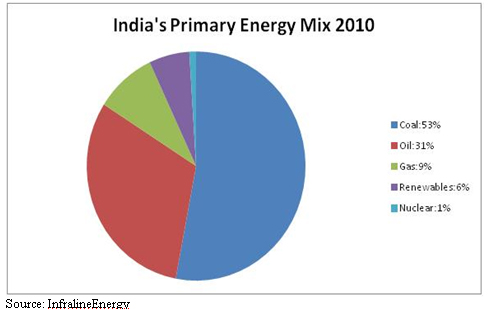India's Green Run
 |
August 2012
By Anumita Raj
|
A few days after the recent mega power outage in India, the Indian Institute of Management, Ahmedabad (IIM-A) announced an accelerator programme aimed at building future clean technology start-ups. Recently, India has initiated several programmes at the policy level for changing its primary energy mix that aim towards India becoming a green economy over the next few years. These programmes may fuel India's journey towards this goal. But the question remains whether India is really doing enough towards this. If India has to take its place amongst the world powers of tomorrow, its efforts would have to match or even better those of its neighbour and competitor China. Also, India's efforts towards a green economy would have to cater to its exploding energy demand over the next two decades.
The United Nations Environment Program defines a green economy as an economy that results in improved human well-being and social equity, while significantly reducing environmental risks and ecological scarcities. In its simplest expression, a Green Economy can be thought of as one which is low carbon, resource efficient and socially inclusive. Such an economy involves investments towards reducing pollution and losses of biodiversity, as well as decreasing carbon emissions and increasing resource efficiency. A green economy is built around sustainability of agriculture, fisheries, forestry, industry, energy, waste management, water management, resources, and infrastructure. The domestic energy mix of nations would determine, to a large extent, the progress of their transition to a green economy.

At present, India is the world's fifth largest energy consumer and according to an Indian Planning Commission report, the country's energy demand will grow by 41% by 2017 from the present. In 2010, India's energy mix was heavily coal dependent; approximately 53% of India's energy mix was coal-based. Between 2007 and 2012, India added 54,000 MW of power capacity; approximately 70% of this was coal-based. This spells high carbon emissions. In comparison, India's neighbour China seems to be in a similar boat as far as its primary energy mix is concerned. Also, both India and China's growth over the last decade has not taken into account environmental and ecological impacts and hence, both countries currently do not have a good report card as far as greenhouse gas emissions are concerned. At present, China holds the position of the world's largest consumer of energy as well as the world's largest emitter of greenhouse gases. In 2010, China's domestic energy mix was made up of 70% dependence on coal. Hydropower, nuclear power and other low emission energy sources accounted for approximately 8%, oil for 18% and natural gas for 4% of the energy mix. Non-hydropower renewable sources of energy accounted for 0.5% of the mix.China is also leading the world in terms of installed renewable energy capacity; in 2010, this was 103.36 GW. In comparison, according to the Indian Ministry of Renewable Energy, in March 2012, India's installed renewable energy capacity was 24.53 GW. But critics say that China's renewable energy production is tilted more in favour of exports with renewable energy technology being one of its fastest growing export industries.Over the past few years, India has taken initiatives at the policy level to aid in its transition to a green economy. In June 2008, the Government of India launched the National Action Plan on Climate Change (NAPCC). There are 8 missions under NAPCC, and the main missions include the National Solar Mission, the National Mission on Enhanced Energy Efficiency and the National Mission on Sustainable Habitat which aim to keep India's greenhouse gas emissions under control and also, fulfil energy requirements.The National Solar Mission aims to get solar power on par with fossil fuel sources in the country's energy mix. The government has ordered solar power installation in all public buildings, and by 2020, the National Solar Mission aims to increase India's solar power capacity by 20,000 MW. The government has also given approval to the private sector for production of solar panels. According to Ernst & Young's renewable energy attractiveness index, India features among the world's top five destinations for solar energy development. India is also world's fifth largest producer of wind energy. Under China's 12th five year plan, reduction of use of coal and oil has been given special emphasis in order to cut carbon emissions. For this, the Chinese government plans to increase the share of natural gas in its energy mix from the current 4% to 10% by 2020. By 2015, China plans to increase the share of non-fossil fuels in its energy mix to 11.3%. The Chinese government plans to increase its installed solar power generating capacity to 15 GW and the wind power capacity to 100 GW by 2015. It also plans to cut down its carbon emissions by 17% by 2015 through the closing of energy intensive enterprises.Recently, the National Development and Reform Commission in China drafted a National Sustainable Economy Development Plan for 2011-2015; this will be submitted to the State Council for approval shortly. Under this plan, demonstration cities, demonstration enterprises and industrial parks will be set up along with preferential pricing, investment, financial and tax policies. The 12th five year plan in China has prioritized the establishment of sustainable economies to support the development of an eco-friendly, resource conserving society. This green qualification will give it an opportunity to silence detractors that question China authority as a world power due to the current state of its carbon emissions.India transition into a green economy is likely to be time-consuming and fraught with challenges, both internal and external. China transition is not likely to be any easier; but its deliberate and focused steps towards a green economy indicate that within the next 15 years, it may just succeed as the next green superpower. For these two giant economies, going green has more value than any other nation. Transition to a green economy may mark the difference between developed and developing nations. In the future, power in the multi-polar world is likely to be determined, to a large extent, by the ability of nations to transform into low-carbon, resource-conservative economies. Above all, a green economy may also mean providing for the burgeoning energy needs of billion-plus populations.
Related Publications
-
.jpg&maxw=50)
Big Questions of Our time: The World Speaks, 2016
Download:Big Questions of Our time: The World Speaks _Full Report
-

-

Second Freedom South Asian Challenge 2005-2025, 2005
read more
Download:Second Freedom South Asian Challenge 2005-2025 Full Report
Related latest News
Related Conferences Reports
-

Global Challenges Conference, October 2016
Download:Global Challenges Conference Report
-

Conference on Responsibility to the Future: Business, Peace and Sustainability, June, 2008
Download:Global Security and Economy: Emerging Issues


